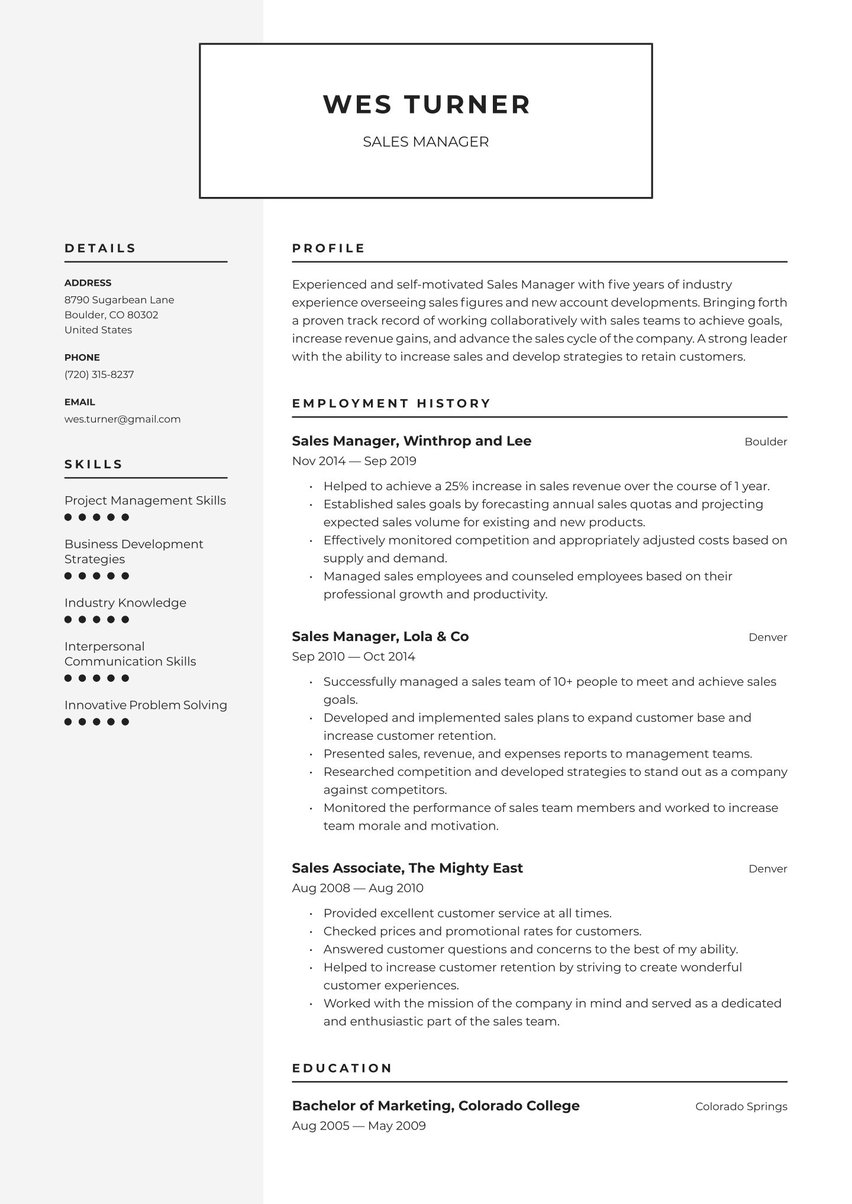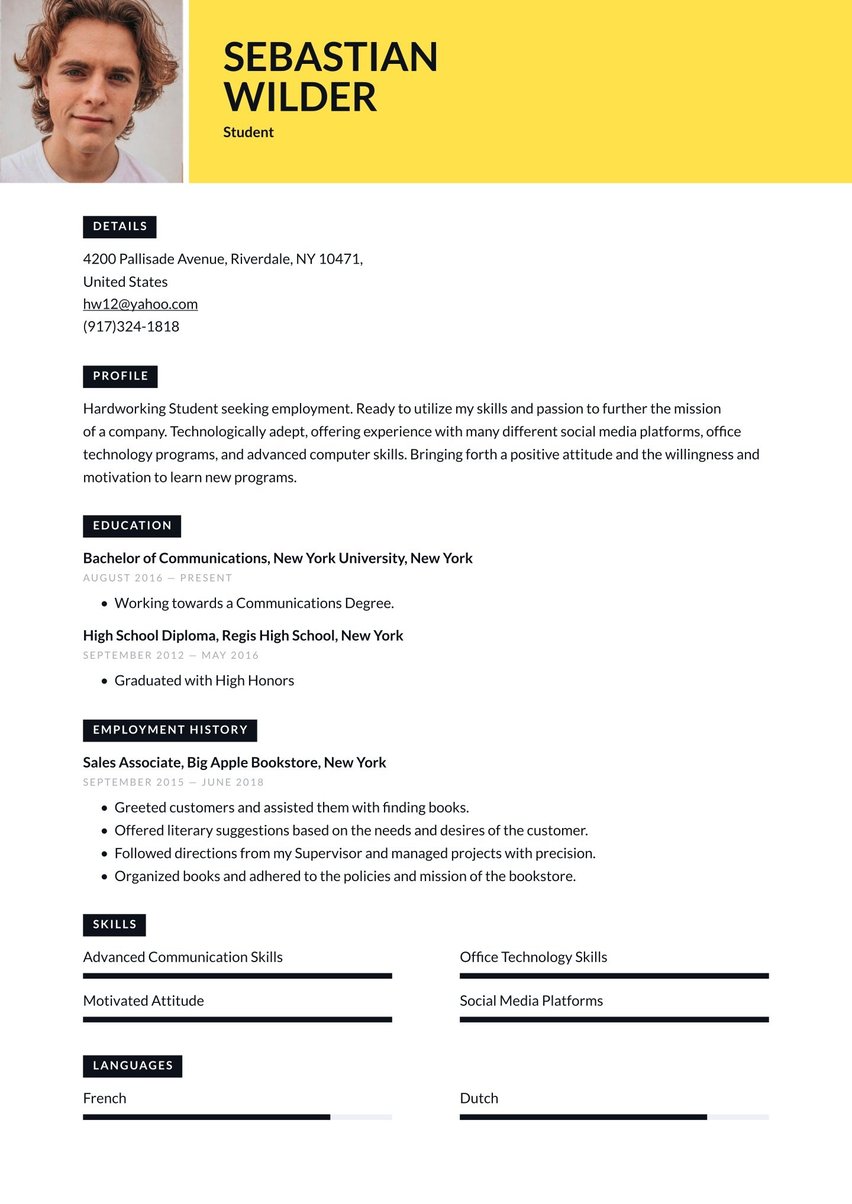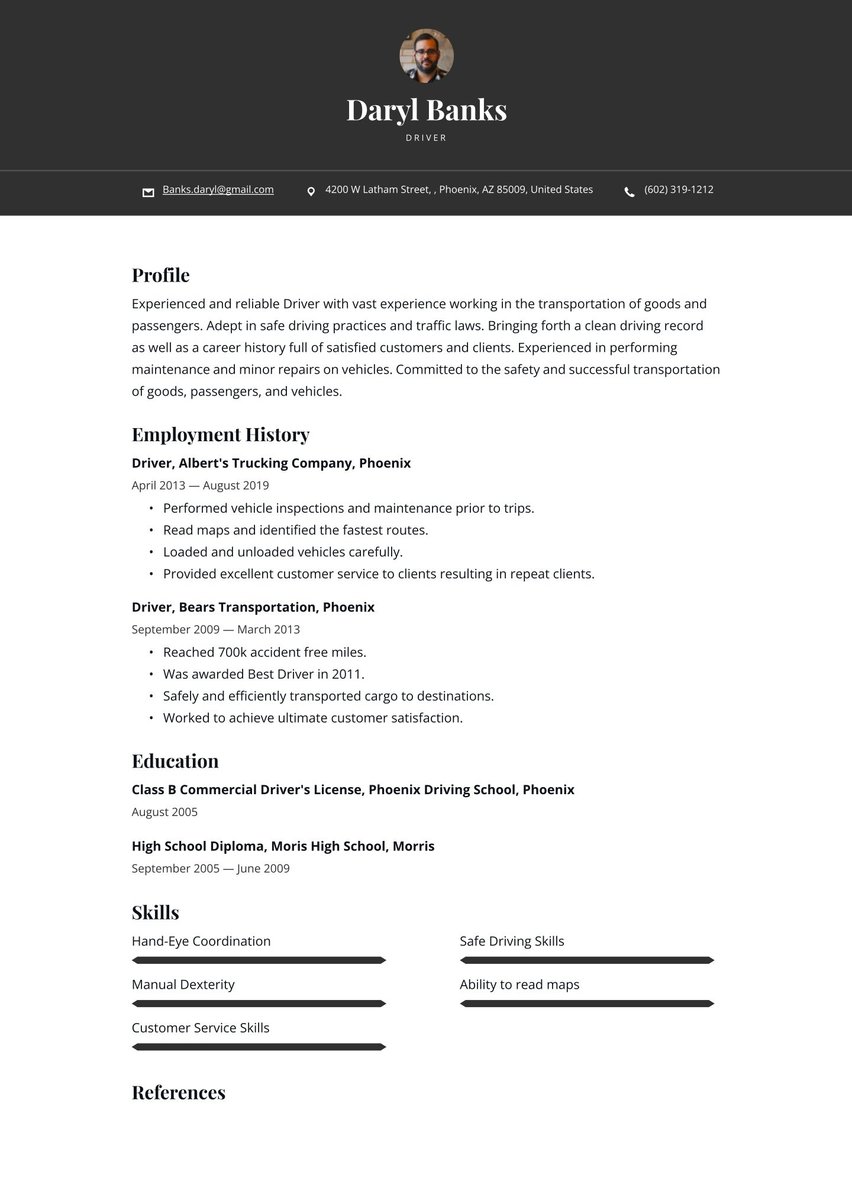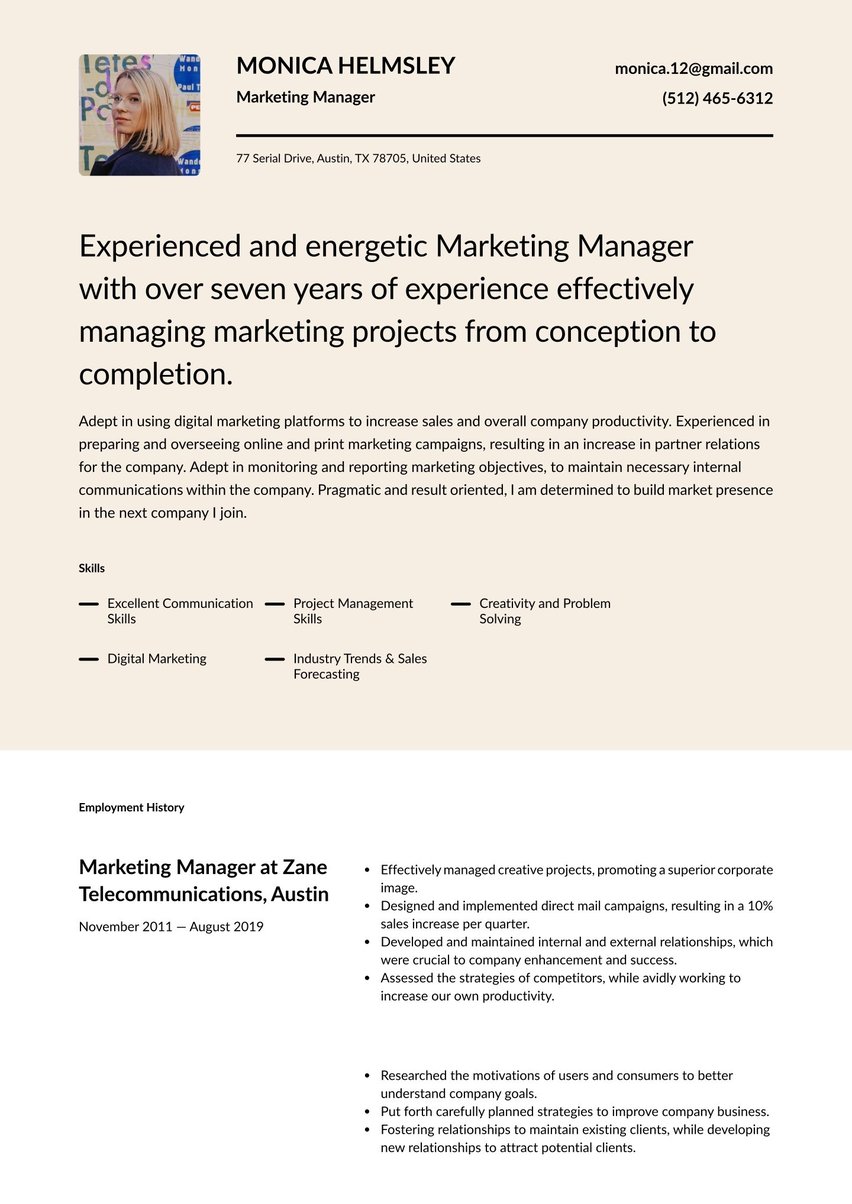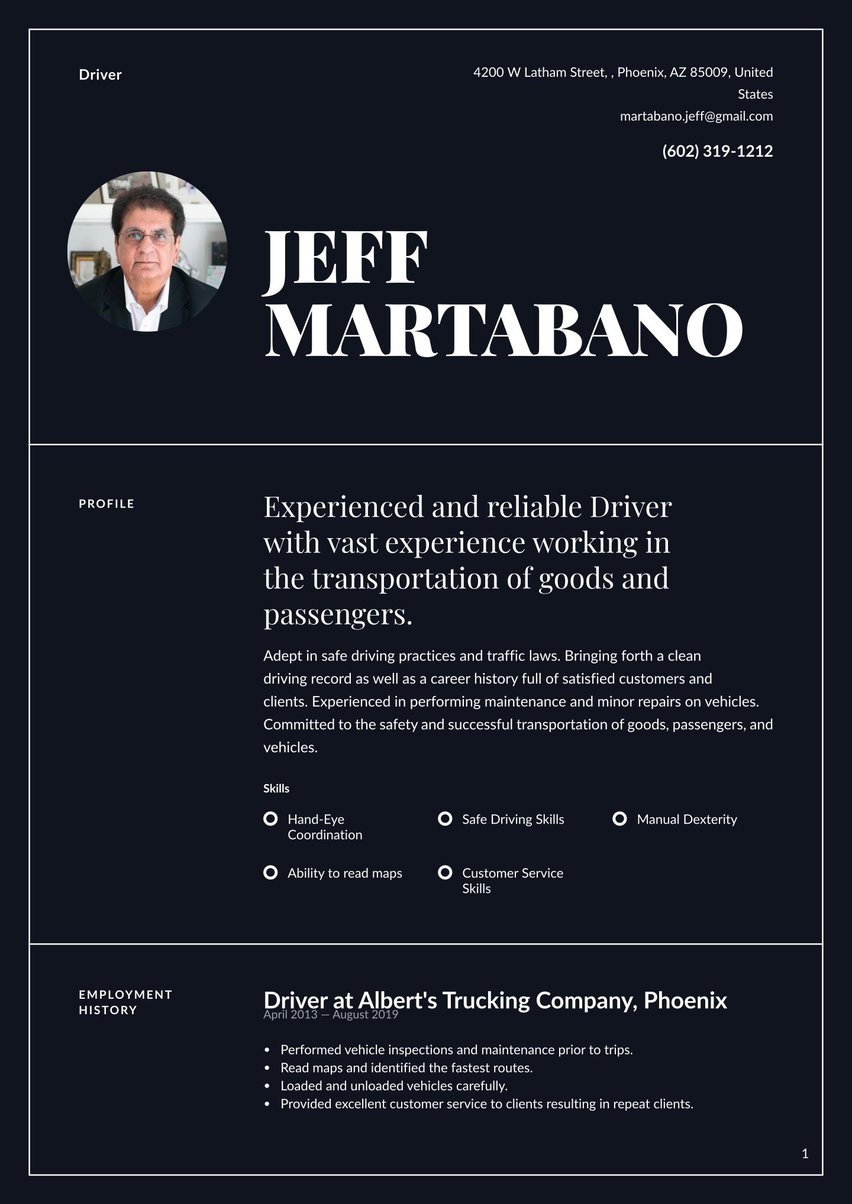06/2013 - 09/2019, Home Health Caregiver, Mount Western Care Group, Hartford
- Provided optimal healthcare to several patients in the comfort of their own home.
- Monitored vital signs, administered medications, and kept up-to-date records of patient progress.
- Assisted patients with various life activities including but not limited to: bathing, dressing, eating, eating, and exercising.
- Reported any changes in a patient's mental or physical health and addressed the situation appropriately.
- Practiced patience and compassion even in the most challenging of situations.
04/2010 - 07/2013, Home Health Caregiver, Hartford Medical Outreach Group, Hartford
- Worked with elderly patients and assisted them in their everyday lives.
- Assessed the physical condition of patients.
- Administered medications and implemented individualized treatment plans.
- Maintained all documentation in compliance with agency standards.
- Aimed to continually provide patients with the highest level of care possible.
08/2009 - 08/2011, Master of Science in Nursing, University of Hartford, Hartford
08/2005 - 05/2009, Bachelor of Biology, Quinnipiac University, Hamden
- Spanish
- Optimal Patient Care Skills
- Compassion and Kindness
- Cleaning and Sanitation Skills
- Multitasking Skills
- Physical Endurance
- Clean Driving Record
- Household Management Skills
Having an effective caregiver resume is the most important tool in your toolbox when it comes to lending a great job. It shows the client that you have the experience and skills and are worthy of their trust.
Caregiver resume examples by experience level
A bland, uninspiring resume can leave you in the lurch. Keep your caregiving career moving forward with a resume that demonstrates not only your skills, but your generous heart, and can improve your chances of landing a position that you find meaningful.
That’s a tall order for a resume, but it can be done. How? By highlighting your skills, accomplishments, and goals.
As a caregiver, you know that it can be difficult for people to place the care of their loved ones in the hands of others. If you leave a negative first impression, you’ve most likely lost them for good.
Whether it’s a private client or the hiring manager at a healthcare company, your resume is your calling card. A well-crafted resume will help you help others, keeping your career on track. Ensure your resume demonstrates your best qualities and motivates them to get to know you further.
Resume guide for a caregiver resume
Give your career the support it needs with Resume.io. Our guides and resume examples cover 500+ professions, and our resume builder makes crafting a great resume easier than ever.
This resume guide and corresponding caregiver resume example will cover the following:
- How to write a caregiver resume
- Choosing the right resume format for caregiving
- How to add your contact information
- Using summaries
- Adding your caregiver experience
- Listing education and relevant experience
- Picking the right resume design/layout
- What the caregiving market looks like and what salary you can expect
How to write a caregiver resume
Before you can get started creating your resume, you need to know what sections to include. Your resume should contain the following elements:
- The resume header
- The resume summary (aka profile or personal statement)
- The employment history section
- The resume skills section
- The education section
A job application is like a log of the patient’s vital signs, in that you’re keeping records of your skills, successes, and experience. Just like getting a patient's history, you need to know the potential employer’s mission, goals, and values, and learn as much as you can about the position you want to obtain to craft a compelling resume that gets you noticed. You need to show them what makes you special; that’s your unique selling proposition and it’s the key that will open the door to a new job.
This process begins with your resume. To open that door, follow this proven formula:
- Highlight accomplishments rather than day-to-day duties, as most people in your role do many of the same basic tasks. What special value did you bring to your previous jobs? Don’t limit this concept to your employment history section; it should be woven into each portion of your resume. Create an overarching theme of achievement.
- Tailor your resume for each job you apply for, tweaking the approach and tone in the same way you’d adapt your style of care to meet each patient’s needs.
- Project your professionalism with a resume template that demonstrates how remarkable you are without being either too arrogant or overly detached.
- If you’re applying online, ensure your resume contains the appropriate keywords so it gets “green flagged” by ATS screening software. Consider using an ATS resume template.
Use keywords to optimize an ATS-friendly resume
ATS stands for Applicant Tracking Systems, which are used by many mid-to-large size companies to screen out applicants. To do this, ATS algorithms scan resumes for keywords—generally included in the job description—and rank them based on how many are included. Only the top-ranking resumes are reviewed by the actual hiring personnel, and the others are discarded.
For example, the caregiver job posting lists the following requirements:
- “Experienced caregiver”
- “3+ years of experience”
- “Current BLS and First Aid Certification”
- “Able to complete Activities of Daily Living (ADLs)”
- “Dispense medication and perform basic light housekeeping duties, including meals.”
Based on these requirements, a resume summary that incorporates these keywords might say:
“Experienced, dedicated caregiver with six years of experience in both facility and home environments. Proven track record providing first-rate care to the elderly and disabled. Skilled in assisting with Activities of Daily living, including medication administration, meal preparation, and personal care.”
Choosing the right resume format for caregiving
Your resume must to be clear, concise, and organized—three qualities that also describe a great caregiver.
The best resume format for most caregiver roles is reverse chronological. This format emphasizes the employment history section, listed in reverse chronological order to give an overview of your career from its start to the present day. Below is an example of this format.
Those looking to start a career as a caregiver (such as young people with little job experience or career changers) may fare better with other resume formats, such as a functional resume, which highlights transferable skills rather than job experience.
When considering the variety of resume templates in our resume builder, choose the format that best presents your current situation. We have a plethora of versions of the three formats available as resume examples.
In terms of design, a caregiver resume should use an uncluttered, straightforward, modern layout that is easy for a health services manager to read and locate the needed information.
Include your contact information
When you send your resume to a prospective employer, you want to make sure of two things: that your contact info front-and-center and the resume provides the information that the reader needs. The header is your resume’s opener. It tells the reader who you are, what you do, and how they can reach you.
It’s very important that your contact information is easy to find and read. It’s also vital that it looks professional so that you’re taken seriously as a candidate.
- Full name & title. Provide your first and last name and then underneath, include the title of the job you’re applying for.
- Professional email address. Your email should be as professional as you are. Use a basic address like firstname.lastname@gmail.com. Avoid silly or immature addresses, and consider using an address that’s separate from your personal email.
- Phone number. Give a number where you can be easily reached, with a professional voicemail greeting.
- Location. Provide just your city and state. Note ' Willing to Relocate' if applicable.
- LinkedIn. If your LinkedIn profile is active and up to date, include it here.
Don’t include:
- Date of birth. It’s irrelevant to the job and might result in age discrimination.
- Personal details. Don’t provide things like religion, marital status, social security number, passport number, etc.
- Photo headshot. Not necessary. If you’re hired and the employer wants to include it in their company database, you can provide one at that time.
Linda Myers
Home Health Caregiver
(203) 955-8493
myrss_8linda@gmail.com
Linda Myers
The Next Florence Nightingale
(203) 955-8493
dogmom23@gmail.com
Make use of a summary
Your profile summary should convey the warmth and charm that makes you a good candidate to nurture and care for others. While these personality traits are important, the summary also includes a small dose of your experience, education and skills.
Your resume summary serves the same purpose as a personal introduction. In 2-3 sentences, you’re introducing yourself as the best qualified person to take extraordinary care of an agency’s patients. An effective summary highlights your caregiving skills and experience and the added-value you bring to the company (and your patients), not just the routine, day-to-day tasks you performed.
Use action verbs in the simple past or present tense—assisted, supported, monitored, administered, managed, and communicated—and include quantifiable achievements you can.
Resume summaries shouldn’t list things that can be found elsewhere on your resume. It provides a “theme,” or overarching view of what makes you the best at what you do; basically, your unique value proposition. For example, “Received the employee of the month certificate from supervisors or colleagues for outstanding care three times in 2023.”
The resume summary is your first opportunity to put your best foot forward, and help a prospective employer see you as the professional you are. Are you a caring, dependable patient-first person or a by-the-book, caregiver who does what’s required but doesn’t go above and beyond? This is your chance to define yourself as well as your professional brand.
Still need a little help crafting your summary? Check out our related resumes:
You can find adaptable caregiver resume example summaries below:
Committed Home Health Caregiver with foundational experience in providing compassionate care to the elderly and individuals with special needs. Skilled in basic healthcare assistance, patient care documentation, and maintaining effective communication. Demonstrates empathy, strong time management, and adaptability, with a focus on enhancing patients’ quality of life. Eager to continue learning and advancing patient care techniques.
Compassionate and experienced Home Health Caregiver specializing in caring for the elderly, persons suffering from illnesses, and those with disabilities. Adept in providing optimal care for those who cannot care for themselves, and those who require a more intense level of patient care. Experienced in assisting clients with getting to and from places, administering medication, performing any medical treatments necessary, preparing and serving meals, and providing home healthcare. Committed to caring for clients in a way that improves their overall quality of life.
Distinguished senior home health caregiver with a robust history of advancing home healthcare management and patient advocacy. Spearheaded caregiver teams, ensuring exceptional care coordination and the development of comprehensive training programs. Renowned for strategic leadership in complex care situations and fostering patient-family relationships.Demonstrates a profound commitment to enhancing patient quality of life through expert care and empathetic engagement.
Outline your caregiver work experience: giving a helping hand
In a reverse-chronological format, List your current (or most recent) job at the top of this section and work your way back to your first job. Don't go back any further than 10-15 years. Avoid irrelevant experience and provide experience that is pertinent to the role you are applying for. If you wish, the other positions can be listed under “Other experience”.
Provide the employer and job title, then describe your contributions in succinct bullet point statements, and don’t write it in the first person (i.e. No use of the word, “I.”) Be specific and use appropriate action verbs: treated, administered, documented, facilitated, assessed, handled, and alleviated.
Instead of listing routine daily tasks, show tangible outcomes of your efforts. For example, have you ever seen bland, task-related statements like these in a caregiver resume?
- "Handled day-to-day patient care needs."
- "Gave medication to patients."
- "Had a good record of patient care."
These statements are generic and could apply to anyone who works as a caregiver; they don’t demonstrate what you’ve achieved as a caregiver and the value you bring to your work. You want to show how you made a difference in your patient’s lives, not that checked tasks of a “to-do” list.
Replace these meaningless platitudes with results-based points. Emphasize results that you brought to both your patients and the company: patient health outcomes, processes, and procedures you made more efficient, etc. Beyond records and lists, consider patient relationships, communication, and empowering patients to invest in maintenance of their health.
Consider these more effective accomplishments:
- "Mentored 5 new interns during the COVID-19 pandemic, providing training and guidance while increasing employee retention rate by 22%.”
- "Facilitated private, in-home care for 15 residents ages 65-85; assisted with activities of daily living (ADLs) such as hygiene, dressing, meals, and medication administration."
- "Created and implemented a new post-discharge process that reduced hospital readmission rates by 30%."
Take a look at the caregiver employment history resume sample below:
Home Health Caregiver at Mount Western Care Group, Hartford
June 2013 - September 2019
- Provided optimal healthcare to several patients in the comfort of their own home.
- Monitored vital signs, administered medications, and kept up-to-date records of patient progress.
- Assisted patients with various life activities including but not limited to: bathing, dressing, eating, eating, and exercising.
- Reported any changes in a patient's mental or physical health and addressed the situation appropriately.
- Practiced patience and compassion even in the most challenging of situations.
Home Health Caregiver at Hartford Medical Outreach Group, Hartford
April 2010 - July 2013
- Worked with elderly patients and assisted them in their everyday lives.
- Assessed the physical condition of patients.
- Administered medications and implemented individualized treatment plans.
- Maintained all documentation in compliance with agency standards.
- Aimed to continually provide patients with the highest level of care possible.
Include the relevant key skills that make you a great caregiver
In your list of skills, include both hard and soft skills that showcase your experience as a caregiver. Hard skills like mobility assistance, housekeeping, and driving are key skills that employers look for when hiring.
While they may seem like a given, don’t forget soft skills like problem-solving, communication skills, empathy, and a dedication to continuous learning.
The Resume.io resume builder provides a number of pre-written key skills you can select as well as proficiency ranges you can set. You can also manually write in your individual, unique skills.
Here’s what the skills box looks like in our caregiver resume template.
- Optimal Patient Care Skills
- Compassion and Kindness
- Cleaning and Sanitation Skills
- Multitasking Skills
- Physical Endurance
- Clean Driving Record
- Household Management Skills
Don’t limit listing skills to just the skills section. Incorporate them throughout your resume by showing how you use them on-the-job. Providing specific examples of how you used those skills, the outcomes, and any achievements you had.
You can accomplish this by highlighting the following in your summary and work experience:
- Your leadership skills, by describing your role in the healthcare team, mentioning the number of people on your team and any tangible accomplishments you facilitated.
- Interpersonal skills by quantifying client outcomes, communication, or patient satisfaction.
- Healthcare technology by demonstrating your skills with mobile health applications, EMR charting, or records management.
To optimize your resume, analyze the job description to determine what specific skills the employer is looking for, and include them if applicable.
Detail your education & relevant caregiver certifications
The education section for caregivers isn’t complicated. Like your work experience, list your academic experience in reverse chronological order. Start with your college degree; don’t list your high school diploma unless you don’t have a lot of work experience or didn’t continue your education.
This section is also a great place to highlight any healthcare certifications or any additional training you’ve received. For example,
- Training and certifications. Professional development classes, workshops, or even online courses that enhance your caregiving skills.
- Internships. List any internships you might have had while in school. Training in other fields might be applicable if you can use it on the job.
- Participation in professional organizations. Belonging to groups like The Professional Association of Caregivers (PAC), show that you’re committed to developing your knowledge and skills in the healthcare industry.
While a reverse-chronological resume works for most situations, if your education or training is particularly impressive or more relevant than your work experience, consider placing this section before your work section. The functional resume format allows for this, emphasizing your education and transferable skills more than work experience.
Master of Science in Nursing, University of Hartford, Hartford
August 2009 - August 2011
Bachelor of Biology, Quinnipiac University, Hamden
August 2005 - May 2009
Pick the right resume layout and design for a caregiver resume
As a caregiver, it’s important to be organized and energetic and instill confidence in your patients and their families. You want to give the impression that you’re capable, knowledgeable, and reliable—because you are.
The design of your resume should do the same thing. You want your resume to engage the hiring manager and show them who you are as a professional. To accomplish this, choose a resume layout that is professional and easy-to-read, without being bland.
It should be striking, but not overdone. It should be a reflection of you: memorable, organized, and thoughtful.
For a caregiver resume, we recommend an uncluttered design with clearly defined sections, an interesting font and no or limited color. You’re a professional who is responsible for the well-being of other human beings. The look of your resume should reflect that. The caregiver resume sample here, for example, uses the Stockholm template—an easy to read layout with delineated sections and a dash of color for visual interest.
There’s no magic wand that will create a well-crafted resume for you, but there are helpful tools like our tried-and-tested resume templates, where the most difficult formatting and structuring is done for you.
Caregiver text-only resume example
Profile
Compassionate and experienced Home Health Caregiver specializing in caring for the elderly, persons suffering from illnesses, and those with disabilities. Adept in providing optimal care for those who cannot care for themselves, and those who require a more intense level of patient care. Experienced in assisting clients with getting to and from places, administering medication, performing any medical treatments necessary, preparing and serving meals, and providing home healthcare. Committed to caring for clients in a way that improves their overall quality of life.
Employment history
Home Health Caregiver at Mount Western Care Group, Hartford
June 2013 - September 2019
- Provided optimal healthcare to several patients in the comfort of their own home.
- Monitored vital signs, administered medications, and kept up-to-date records of patient progress.
- Assisted patients with various life activities including but not limited to: bathing, dressing, eating, eating, and exercising.
- Reported any changes in a patient's mental or physical health and addressed the situation appropriately.
- Practiced patience and compassion even in the most challenging of situations.
Home Health Caregiver at Hartford Medical Outreach Group, Hartford
April 2010 - July 2013
- Worked with elderly patients and assisted them in their everyday lives.
- Assessed the physical condition of patients.
- Administered medications and implemented individualized treatment plans.
- Maintained all documentation in compliance with agency standards.
- Aimed to continually provide patients with the highest level of care possible.
Skills
- Optimal Patient Care Skills
- Compassion and Kindness
- Cleaning and Sanitation Skills
- Multitasking Skills
- Physical Endurance
- Clean Driving Record
- Household Management Skills
Education
Master of Science in Nursing, University of Hartford, Hartford
August 2009 - August 2011
Bachelor of Biology, Quinnipiac University, Hamden
August 2005 - May 2009
Caregiver job market and outlook
The demand for caregivers is on the rise, mainly due to the increase in the aging population and the fact that the cost of long-term care services are rising so that it is largely shifting from facilities like nursing homes, to home- and community-based settings.
- Approximately 718,900 openings for caregivers are projected each year over the next decade.
- More than 1 in 6 adults report taking care of an elderly or disabled family member.
- More than 3 million Americans are currently employed as paid caregivers in nursing homes, adult day services programs, and directly in clients homes.
What type of salary you can expect as a caregiver
Caregivers can earn a yearly salary or an hourly wage, depending on whether they work for an agency, the type of work, and experience level. Currently the median annual wage for home health and personal care aides is $33,530.
Salaries for similar roles:
- Medical Assistants $42,000
- Licensed practical nurses (LPNs) and licensed vocational nurses (LVNs) $59,6730
- Nursing Assistants $38,130
- Occupational Therapy Assistants and Aides $65,450
Key takeaways for building a caregiver resume
Caregiving can be a fulfilling career for those who desire to help others in a hands-on, meaningful way. A caregiver must have a strong sense of empathy as well as strong communication and organizational skills to be successful. They should also be committed to both the welfare of others as well as developing their professional skills.
Unlock 18 powerful tools to search for jobs, track your progress, ace your interviews, and negotiate the best salary—all within our comprehensive career toolkit.


.jpg)

.jpg)



















